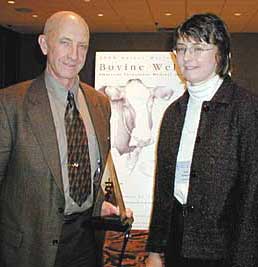Innovator in bovine housing standards gains welfare award
For his pioneering spirit in the areas of animal housing and dairy barn ventilation standards, Dr. John F. Anderson was awarded the 2000 AVMA Animal Welfare Award. Dr. Anderson accepted the award with his daughter, Laurie, who manages his veterinary consulting service in Minnesota. "The significance of being a veterinarian is working on a small corner of creation," he said. After his discharge from the Army in 1954, Dr. Anderson went on to graduate from the University of Minnesota College of Veterinary Medicine in 1962. As a private practitioner, he found animals housed in settings that compromised their health, productivity, and well-being. "One of my client's dairy farms was experiencing a 100 percent death loss when calves were born in the dairy barn in the winter," he recounted. "I looked at the situation and applied some basic bacteriological principles. We used small poultry housing facilities, which individually separated the calves, and calf death losses dropped to zero." Dr. Anderson continued in private practice until 1966, when he returned to his alma mater as a faculty member, where he worked for nearly 30 years. There he met the late Donald Bates, PhD, an agricultural engineer. Together the men developed a joint interest in providing a comfortable, clean environment for cattle, with Dr. Anderson focusing on animal health and Dr. Bates taking on the environmental stress perspective. By controlling airflow and providing proper ventilation, they designed housing systems that dramatically improved animal welfare and reduced respiratory disease in cattle. "Our principles focused on disease prevention and how the environmental design interacts with animal stress, organism virulence, and the number of 'bugs' shed." Dr. Anderson and professor Bates designed cow maternity units that were clean, disinfected, ventilated, and isolated from the rest of the herd. Today these units can be monitored by videocamera. After birth, calves are moved to a combination warmer/dryer unit; they are then placed in open-ended individual hutches, where they wear insulated coats in winter for the first 10 to 12 days after birth to guard against hypothermia and hypoglycemia. Dr. Anderson's patented hutch design uses a sliding fence that protects calves from harsh winter elements and prevents snow from entering the interior of the calf hutch. Cattle on dairy farms are found in a variety of housing units, depending on age and stage of lactation. Designs by the Anderson-Bates team have been accepted nationally and internationally. Their research has become a part of many veterinary school programs. As a result of these innovations, cattle well-being has been advanced. | ||
